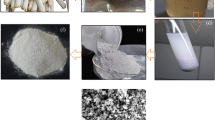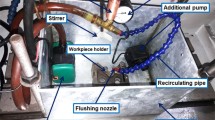Abstract
Pulsed electrochemical machining (PECM) has been conducted for invar (Fe-Ni) fine sheet consisting of 64 % Fe ions and 36 % Ni ions. Solutions of sodium chloride (NaCl), acetic acid (CH3COOH), sodium nitrate (NaNO3), and sodium nitrite (NaNO2) mixed with sodium tartrate (C4H4Na2O6) were used as an electrolyte. First, the electrical conductivities of all electrolytes have been measured. As the concentration of each electrolyte increased, the electrical conductivities of electrolytes increased except for the acetic acid. The electrochemical machinability has been investigated using four types of electrolytes. The results of PECM show that the electrolyte which has the high electrical conductivity value leads to the low electrochemical machinability. The pulse waves which indicate the electrical characteristics during the PECM has been observed and it is confirmed that the passivating oxide film occur in PECM. To compare the capability of changing in transpassive state, the anode surface has been investigated. This study presents the relationship between electrical conductivity and electrical machinability. Moreover, the capacity of changing in transpassive state has been investigated as compared with four types of electrolytes. This study shows the possibility of applying invar fine sheet in PECM and contributes to determining the electrolyte for the process.
Similar content being viewed by others
References
Kim SH, Choi SG, Choi WK, Yang BY, Lee ES (2014) Pulse electrochemical machining on invar alloy: optical microscopic/SEM and non-contact 3D measurement study of surface analyses. Appl Surf Sci 314:822–831
Yanchong Y, Weiqing C, Hongguang Z (2014) Research on the hot ductility of Fe-36Ni invar alloy. Rare Metal Mater Eng 43:2969–2973
Martini E, Amaral S, Müller I (2004) Electrochemical behavior of invar in phosphate solutions at pH = 6.0. Corros Sci 46:2097–2115
Jeong HC, Kim DW, Choi GM, Kim DJ (2009) The effect of spray characteristics on the etching of invar alloy with FeCl3 solution. Int J Precis Eng Manuf 10:107–114
Lu DZ, Wu MJ (2014) Observation of etch pits in Fe-36wt% Ni invar alloy. Int J Miner Metall Mater 21:682–686
Park NJ, Oh MH, Kim SM (2000) Effects of texture on the etching property of Fe-36% Ni invar sheets. Met Mater 6:51–56
Ahn SH, Ryu SH, Choi DK, Chu CN (2004) Electro-chemical micro drilling using ultra short pulses. Precis Eng 28:129–134
Das AK, Saha P (2013) Machining of circular micro holes by electrochemical micro-machining process. Adv Manuf 1:314–319
Choi SH, Ryu SH, Choi DK, Chu CN (2007) Fabrication of WC micro-shaft by using electrochemical etching. Int J Adv Manuf Technol 31:682–687
Qu NS, Xu ZY (2013) Improving machining accuracy of electrochemical machining blade by optimization of cathode feeding directions. Int J Adv Manuf Technol 68:1565–1572
Tang L, Li B, Yang S, Duan Q, Kang B (2014) The effect of electrolyte current density on the electrochemical machining S-03 material. Int J Adv Manuf Technol 71:1825–1833
Choi SH, Kim BH, Shin HS, Chu CN (2013) Analysis of the electrochemical behaviors of WC–Co alloy for micro ECM. J Mater Process Technol 213:621–630
Haisch T, Mittemeijer E (2002) Electrochemical machining: the role of steel microstructure in high-rate anodic dissolution. J Miner, Metals Mater Soc 54:38–41
Weinmann M, Stolpe M, Weber O, Busch R, Natter H (2015) Electrochemical dissolution behavior of Ti90Al6V4 and Ti60Al40 used for ECM applications. J Solid State Electrochem 19(2):485–495
Bannard J (1974) The use of surface-active additives in electrochemical machining electrolytes. J Appl Electrochem 4:117–124
Wang D, Zhu Z, Wang N, Zhu D, Wang H (2014) Investigation of the electrochemical dissolution behavior of Inconel 718 and 304 stainless steel at low current density in NaNO 3 solution. Electrochim Acta 156:301–307
Haisch T, Mittemeijer E, Schultze J (2001) Electrochemical machining of the steel 100Cr6 in aqueous NaCl and NaNO3 solutions: microstructure of surface films formed by carbides. Electrochim Acta 47:235–241
Haisch T, Mittemeijer E, Schultze J (2004) High rate anodic dissolution of 100Cr6 steel in aqueous NaNO 3 solution. J Appl Electrochem 34:997–1005
Datta M, Landolt D (1977) On the influence of electrolyte concentration, pH and temperature on surface brightening of nickel under ECM conditions. J Appl Electrochem 7:247–252
Wang D, Zhu Z, Bao J, Zhu D (2014) Reduction of stray corrosion by using iron coating in NaNO3 solution during electrochemical machining. Int J Adv Manuf Technol 76(5):1365–1370
Lee ES, Shin TH, Kim BG, Baek SY (2010) Investigation of short pulse electrochemical machining for groove process on Ni-Ti shape memory alloy. Int J Precis Eng Manuf 11:113–118
Rathod V, Doloi B, Bhattacharyya B (2013) Parametric investigation into the fabrication of disk microelectrodes by electrochemical micromachining. J Micro Nano Manuf 1(4):1–11
Sharma S, Jain VK, Shekhar R (2002) Electrochemical drilling of inconel superalloy with acidified sodium chloride electrolyte. Int J Adv Manuf Technol 19:492–500
Ryu SH (2009) Micro fabrication by electrochemical process in citric acid electrolyte. J Mater Process Technol 209:2831–2837
Author information
Authors and Affiliations
Corresponding author
Rights and permissions
About this article
Cite this article
Chun, K.H., Kim, S.H. & Lee, E.S. Analysis of the relationship between electrolyte characteristics and electrochemical machinability in PECM on invar (Fe-Ni)fine sheet. Int J Adv Manuf Technol 87, 3009–3017 (2016). https://doi.org/10.1007/s00170-016-8648-7
Received:
Accepted:
Published:
Issue Date:
DOI: https://doi.org/10.1007/s00170-016-8648-7




